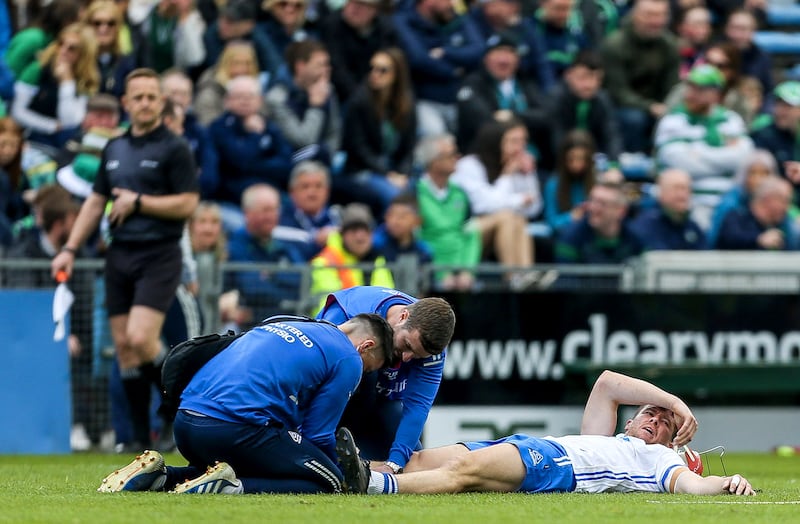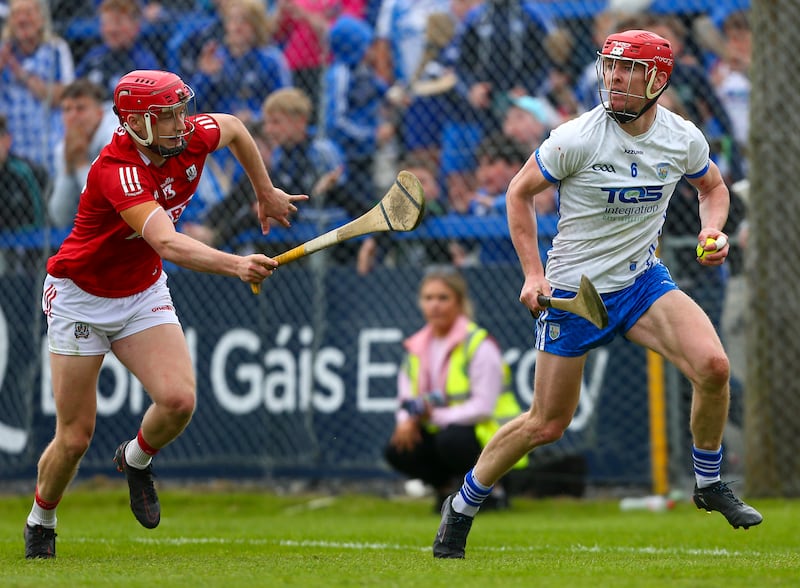Tadhg De Búrca is predictable. People like that. Nobody needs to think twice or look twice. There are no sudden movements. No mood swings, no loudness, no demands, no fuss. He makes things simple for people. He invites trust. Without asking. Your trust is safe. So, when he ruptured his ACL for the first time in 2019, everyone believed he would come back, as good as before. Second time, 14 months later? Same.
Then he ruptured his Achilles tendon, 22 minutes into the first match of the 2023 championship, and people wondered if there was a limit. Even for him. Even knowing everything they knew about him.
The recovery from his first ACL had taken nine months; the next one had consumed a year. Between the 2020 All-Ireland final, when he collapsed in a heap under the Cusack Stand, and his next intercounty match there were 427 days. The 2021 season was a write-off. He came back.
He fell down. April 2023: carried from the field in Thurles against Limerick. A couple of months later Dan Shanahan saw him in Moves Gym in Dungarvan, limping. Down again. Up again. Starting again. “I was thinking, it’s not just the body, it’s the mental side of this,” says Shanahan. “To come back from two cruciates and now face into this.”
RM Block

Brian O’Halloran met him for coffee. O’Halloran was the first player from Clashmore/Kinsalebeg to play senior championship for Waterford, at the beginning of the last decade, and De Búrca was the second, four years later. “He wasn’t long blowing me out of the water.” They chatted about what De Búrca faced next. Only one of them had processed it.
“I would have said after last year’s injury, I didn’t know how he was going to even attempt to play this year,” says O’Halloran. “I’m just stunned that he had the appetite and the will to give another winter of hardship and come out the other side of it.
“I can’t get into that mindset. There are days when you must be thinking ‘I have to skip the gym today’, and he just doesn’t. He comes back like clockwork. His diligence in the gym and his obsession about getting his body right after the injuries is unbelievable. Time was tight to make it for the Cork match. Despite it being a year-long injury, he was up against the clock to make it.”
After the Cork match in Walsh Park a fortnight ago, Derek McGrath sought out De Búrca on the pitch. McGrath’s youngest son idolises him and they were scouting for a picture. On that track McGrath met some people from Clashmore, thinking what he was thinking.
“We were all just kind of worried about him,” says McGrath. “You’d be worried about his health, as much as anything else, because of what he’s been through. You’d have your heart in your mouth, hoping he’ll get through it. But then you see him rocking into tackles and coming out with ball after ball.”

McGrath gave De Búrca his championship debut against Cork, 10 years ago, four months shy of his 20th birthday. In the match programme he was listed as Tadhg Burke, wearing number two but playing at number seven. Among other things he flaked a ball over the bar from nearly 80 yards. Everybody was just getting to know him.
A year later McGrath shifted De Búrca to the centre of the Waterford defence. Jamie Barron was relocated to centrefield. After a gruelling first year as manager McGrath culled nine established players from the panel and gambled everything on a new plan.
For 2015 Waterford’s tactical deviance would be expressed through De Búrca and Barron more than any other players. De Búrca was a defender first and a trigger for counter-attacks second. Barron was the next bridge between defence and attack. In Waterford’s wheel, they were the hub.
Off the field they became close friends in UCC, even though they couldn’t have been less alike. Barron is fizzy and mischievous; De Búrca is reserved. He was asked once in an interview to describe himself in three words and the first word he uttered was “quiet.” That first impression is never revised.
“Very, very quiet,” says Stephen Frampton, the former Waterford player, who was a selector during Liam Cahill’s time as Waterford manager. “A very quiet fella. Says what needs to be said, but in a very low tone even when he does say it.”
In the early summer of 2016 Waterford spent a week in Fota Island. Before they went into camp McGrath organised a scrapbook for every player, asking their parents and former teachers to come up with memories and remarks and pictures. Before the scrapbooks were given to the players McGrath took a peek at De Búrca’s.
“Everything written was about his behaviour – how gracious and classy he was. There is nothing worse than false humility. This fella is just the nicest fella you’ll ever meet but with an absolutely ruthless edge as well.”

Waterford reached the All-Ireland semi-final that season. When they returned to the All-Ireland semi-final a year later De Búrca was suspended. Waterford exhausted every avenue in their appeal. On the day of the All-Ireland semi-final all the players and management had the number 5 written on the back of their hands, De Búrca’s shirt number that season. It was a gesture of solidarity; the rights and wrongs of the suspension were immaterial.
“People think these things are corny or gimmicky,” says McGrath, “but it’s hard to explain how central he was to the whole thing. It was almost hidden. He went through the wringer over the suspension. I remember meeting him in the car park of the Louis Fitzgerald Hotel [after the appeal hearing] and it was the first time I saw him genuinely emotional about something.”
By then, McGrath and Waterford were stuck in a culture war. In a punkish break from convention De Búrca was deployed as an extra defender. In hurling sweepers were new and not mainstream and fiercely resisted. Those who welcomed it as a tactical innovation were in a minority and widely heckled. Those who hated the practice were often furious in their condemnation. It is a dead argument now.
In any case, De Búrca mastered it. In 2015, in his breakout season in the role, he was named Young Hurler of the Year and the All Star centre back. On stage at the All-Stars’ banquet Joanne Cantwell asked him about Waterford’s “system”, the water cooler conversation that had dominated the hurling year. Grappling with his shyness De Búrca said something about everybody else making it easy for him. Modesty and deflection have always been twins.
“He was subjected to the most lazy commentary of all time in terms of being branded a sweeper and nothing else,” says McGrath. “He’d tell you himself, if you asked him, in 2015 and ‘16, when the whole country was branding him as a sweeper, he was actually just not following his man and there was no man detailed to mark his man. What he combined brilliantly was marking and sweeping and touch and guile and ferocity. In terms of the evolution of the role he’s done everything through the years.”

When Waterford lost the 2017 All-Ireland final De Búrca had 24 possessions, a staggering number, and greater than any other player on the pitch. When Cahill took over as manager Waterford played with a different system and De Búrca was encouraged to attack. In that role he had 18 possessions in the 2020 All-Ireland semi-final against Kilkenny, more than anybody else on the pitch. He could play it any which way. De Búrca finished that season with a ruptured ACL and the All-Star for centre back.
What never changed was his presence. “He’s acted as an anchor for the team for the bones of a decade,” says Stephen O’Keeffe, the former Waterford goalkeeper. “Everyone orbited around him. When you have someone like that in the centre back position players look to you for leadership. You don’t have to be the man in the dressingroom, f-ing and blinding and geeing everyone up. People know he will carry the fight.
“There was always a sense of calm around him. When there was a ball dropping in around the square, he was the man to go up and claim it. He was someone you were proud to take the field with.”
When De Búrca returned from his first ACL injury Covid had delayed the 2020 intercounty championship until early winter. Before that, there were club games. Clashmore/Kinsalebeg played eight weeks in a row. De Búrca “didn’t hit the ground running,” says O’Halloran. “The first few games back he was as nervous as you’d expect after a big injury.”
By the end of that run of games the wrinkles had been ironed out. The next recovery, though, was longer and more painful because the skin graft needed to come from his hamstring. At the time he was living in Dublin and he retreated into a bubble.
“He didn’t want to be involved in the set-up while he was recuperating,” says Frampton. “He just went off and did his own recovery programme. If it was another player you’d be checking in pretty regularly to make sure he was going well. With Tadhg there was no need.
“This time, you’d often question whether he was going to come back, or what way he was going to come back. You’d wonder whether he’d be able to get back to the same level of performance. The Cork game showed he definitely could. They say that Rolls-Royces break down more than Morris Minors because they have such a finely tuned engines. That’s how I would class him. A Rolls-Royce.”
There were 364 days between the last injury and the latest comeback. Every day in the jersey is precious now.























